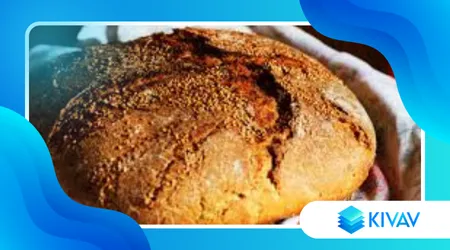Castelvetrano Black Bread: Sicilian Bread Made with Tumminia Flour

Black bread from CastelvetranoThis bread is not simply a dough of flour and water, but the expression of an unbreakable bond with the Trapani region.
Announcements
The Black bread from Castelvetrano It stands out for the combined use of re-milled Sicilian durum wheat semolina and a significant percentage of tumminia flour, also known as timilia.
The use of this specific stone-ground flour gives the loaf its characteristic dark color and a unique and inimitable aromatic profile.
Tradition dictates the use of sourdough starter, known locally as “lu criscenti,” and rigorous baking in stone ovens fueled by olive branches, a detail that adds a further, precious sensorial nuance.
How does tumminia flour shape flavor and texture?
Tumminia, an ancient short-cycle wheat (quarterly, hence the Greek name trimenaos), boasts intrinsic properties that make it exceptional.
Announcements
Unlike modern wheats, which undergo intense genetic modification, this wheat has retained its original qualities intact, including a less tenacious and more digestible gluten.
Its stone grinding preserves the germ and bran, essential elements for the nutritional profile and final taste.
The resulting bread has a hard, dark crust, often sprinkled with sesame seeds, which encloses a soft, compact but not rubbery crumb, with a slightly sweet and persistent flavour.
What are the nutritional and health benefits of Castelvetrano black bread?
Choosing a product like the Black bread from Castelvetrano It means choosing health without giving up taste.
The use of ancient grains such as tumminia and the wholemeal or semi-wholemeal stone grinding guarantee a superior nutritional intake compared to common breads.
Learn more: Neapolitan fried pizza
Timilia wheat, by its nature, has a lower glycemic index and a high protein and fiber content.
These elements help regulate the absorption of sugars and promote a prolonged feeling of satiety.
How do the nutritional values of tumminia bread compare?
For your information, several studies have highlighted the excellent properties of breads made with ancient grains.
According to analyses conducted in collaboration with the University of Catania, tumminia bread has a particularly interesting nutritional profile.
| Nutritional Component | Tumminia Bread (per 100g) | Common Soft Wheat Bread (per 100g) |
| Calories (kcal) | Approximately 270 – 310 | Approximately 240 – 270 |
| Protein (g) | Approximately 12.0 – 15.0 | Approximately 8.0 – 10.0 |
| Fiber (g) | Approximately 4.5 – 6.0 | About 2.5 – 3.5 |
Average data based on studies and analyses of samples of Sicilian ancient grain bread and common white bread.
This table highlights how tumminia bread, despite having a comparable caloric intake, offers a higher protein and fiber content, contributing significantly to a balanced diet and intestinal well-being.
++ Focaccia with boiled potatoes
Furthermore, scientific research continues to explore the hypothesis that ancient grain proteins may be better tolerated by subjects with non-celiac gluten sensitivity.

Why is Castelvetrano Black Bread an example of sustainability and biodiversity protection?
The recovery and valorization of the Black bread from Castelvetrano and tumminia flour represent a battle won for agricultural biodiversity.
For years, ancient grains were almost forgotten in favor of more productive varieties.
Interesting: Artichoke carpaccio with parmesan shavings and lemon
Fortunately, the commitment of local farmers, millers, and bakers, often grouped together in consortia, has allowed this cultivation to be revived.
Agriculture based on these grains is often less intensive and requires less irrigation and fertilizer, making it more environmentally sustainable.
Protecting tumminia means safeguarding an entire agricultural ecosystem.
What recent initiatives protect this heritage?
The Black Bread of Castelvetrano is recognized as Slow Food Presidium, a brand that certifies its excellence, rarity and adherence to strict production specifications.
The goal of the Presidium, established in 2008, is to protect the authenticity and promote the artisanal work of the few bakers who still respect the original recipe.
An example of this protection is the recent push (in 2024/2025) to obtain the PDO (Protected Designation of Origin) label, a step that would definitively secure the quality and geographical origin of this extraordinary product, protecting it from unauthorized imitations.
Imagine walking into an art gallery. Modern paintings, with their bold lines and vibrant colors, immediately catch your attention.
The Black bread from Castelvetrano, on the contrary, it is like a Renaissance sculpture.
It doesn't seek immediate impact, but reveals its depth and beauty only to those who approach with respect and curiosity, admiring its texture, the history etched into every crack in the crust, and the enduring aroma. It's not a mass-produced product, but a work of culinary art.
Another example of uniqueness is found in its use.
In Castelvetrano, the "vastedda" (the typical round shape) is traditionally seasoned with local extra virgin olive oil, salt, oregano, and, in a typical variation, salted sardines pressed into the breadcrumbs. This combination enhances the sweet flavor of the bread with the saltiness of the fish, creating a harmony of flavors that is the quintessential Sicilian cuisine.
This is the essence of true bread culture, which goes beyond simple nutritional function.

How to recognize and appreciate authentic Castelvetrano black bread?
For the enthusiast or the attentive consumer, distinguishing the authentic Black bread from Castelvetrano It requires a critical eye and knowledge of some fundamental details.
The first clue is the appearance: a thick, dark, almost deep brown crust, and a shape that can be round (vastedda) or elongated (strand).
The aroma is the second crucial element, it must be complex, with notes of toasted cereal, hazelnut and a light hint of honey.
If it's not made in Sicily, can it be called Castelvetrano Black Bread? Absolutely not. Authenticity lies in the entire supply chain, from the seed to the milling and baking.
Purchasing from bakeries displaying the Slow Food Presidium logo offers the maximum guarantee.
What are the new prospects for the future of ancient grains in Italy?
The interest towards the Black bread from Castelvetrano and ancient grains in general are not a passing phenomenon.
On the contrary, it represents a consolidated and growing trend.
According to Coldiretti, in Sicily, the area cultivated with ancient grains, including tumminia, has seen an increase of 20% in the last three years (data updated to 2024), a tangible sign of how consumer demand is driving a return to origins.
This boom not only generates value for local economies but also restores the dignity of an agricultural profession that for too long has been crushed by the logic of immediate profit.
Castelvetrano black bread is much more than just a food. It's a manifesto of culture, a bastion of sustainability, and a culinary delight that speaks the sincere and passionate language of Sicily.
Its long shelf life, up to ten days if stored properly, is another virtue that reminds us that bread was once the cornerstone of every meal, a precious commodity never to be wasted.
It's a life lesson, don't you think?
Frequently Asked Questions
1. Where can I find authentic Castelvetrano black bread outside of Sicily?
Many Slow Food Presidium bakers ship their bread throughout Italy and sometimes abroad, often vacuum-packed or in a modified atmosphere to preserve its exceptional freshness.
Look for authorized online retailers or shops specializing in typical Sicilian products.
2. Does tumminia flour contain gluten?
Yes, tumminia flour is made from durum wheat and contains gluten, although in different quantities and qualities than modern wheat. It is therefore not suitable for people with celiac disease.
3. What is the difference between tumminia and other ancient Sicilian grains such as Senatore Cappelli?
Senatore Cappelli is an ancient durum wheat, also of high quality, often used in bread and pasta making.
Tumminia (or timilia) is distinguished by its shorter growth cycle and its specific organoleptic and color characteristics, which are the basis of the recipe for Castelvetrano Black Bread.
++ the recipe to make it at home
++ Black Bread
